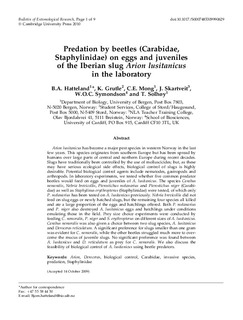| dc.contributor.author | Hatteland, B.A. | |
| dc.contributor.author | Grutle, K. | |
| dc.contributor.author | Mong, C. E. | |
| dc.contributor.author | Skartveit, J. | |
| dc.contributor.author | Symondson, W.O.C. | |
| dc.contributor.author | Solhøy, T. | |
| dc.date.accessioned | 2010-12-02T10:56:38Z | |
| dc.date.available | 2010-12-02T10:56:38Z | |
| dc.date.issued | 2010 | |
| dc.identifier.citation | Bulletin of Entomological Research, 1-9 | en_US |
| dc.identifier.issn | 0007-4853 | |
| dc.identifier.uri | http://hdl.handle.net/11250/152124 | |
| dc.description.abstract | Arion lusitanicus has become a major pest species in western Norway in the last
few years. This species originates from southern Europe but has been spread by
humans over large parts of central and northern Europe during recent decades.
Slugs have traditionally been controlled by the use of molluscicides; but, as these
may have serious ecological side effects, biological control of slugs is highly
desirable. Potential biological control agents include nematodes, gastropods and
arthropods. In laboratory experiments, we tested whether five common predator
beetles would feed on eggs and juveniles of A. lusitanicus. The species Carabus
nemoralis, Nebria brevicollis, Pterostichus melanarius and Pterostichus niger (Carabidae)
as well as Staphylinus erythropterus (Staphylinidae) were tested, of which only
P. melanarius has been tested on A. lusitanicus previously. Nebria brevicollis did not
feed on slug eggs or newly hatched slugs, but the remaining four species all killed
and ate a large proportion of the eggs and hatchlings offered. Both P. melanarius
and P. niger also destroyed A. lusitanicus eggs and hatchlings under conditions
emulating those in the field. Prey size choice experiments were conducted by
feeding C. nemoralis, P. niger and S. erythropterus on different sizes of A. lusitanicus.
Carabus nemoralis was also given a choice between two slug species, A. lusitanicus
and Deroceras reticulatum. A significant preference for slugs smaller than one gram
was evident for C. nemoralis, while the other beetles struggled much more to overcome
the mucus of juvenile slugs. No significant preference was found between
A. lusitanicus and D. reticulatum as prey for C. nemoralis. We also discuss the
feasibility of biological control of A. lusitanicus using beetle predators. | en_US |
| dc.language.iso | eng | en_US |
| dc.publisher | CAB International Publishing | en_US |
| dc.relation.ispartofseries | Bulletin of Entomological Research; | |
| dc.subject | Biologi | en_US |
| dc.title | Predation by beetles (Carabidae, Staphylinidae) on eggs and juveniles of the Iberian slug Arion lusitanicus in the laboratory | en_US |
| dc.type | Journal article | en_US |
| dc.type | Peer reviewed | en_US |
| dc.source.pagenumber | 1-9 | en_US |
